Halderman J.D., Linder J. Automotive Fuel and Emissions Control Systems
Подождите немного. Документ загружается.

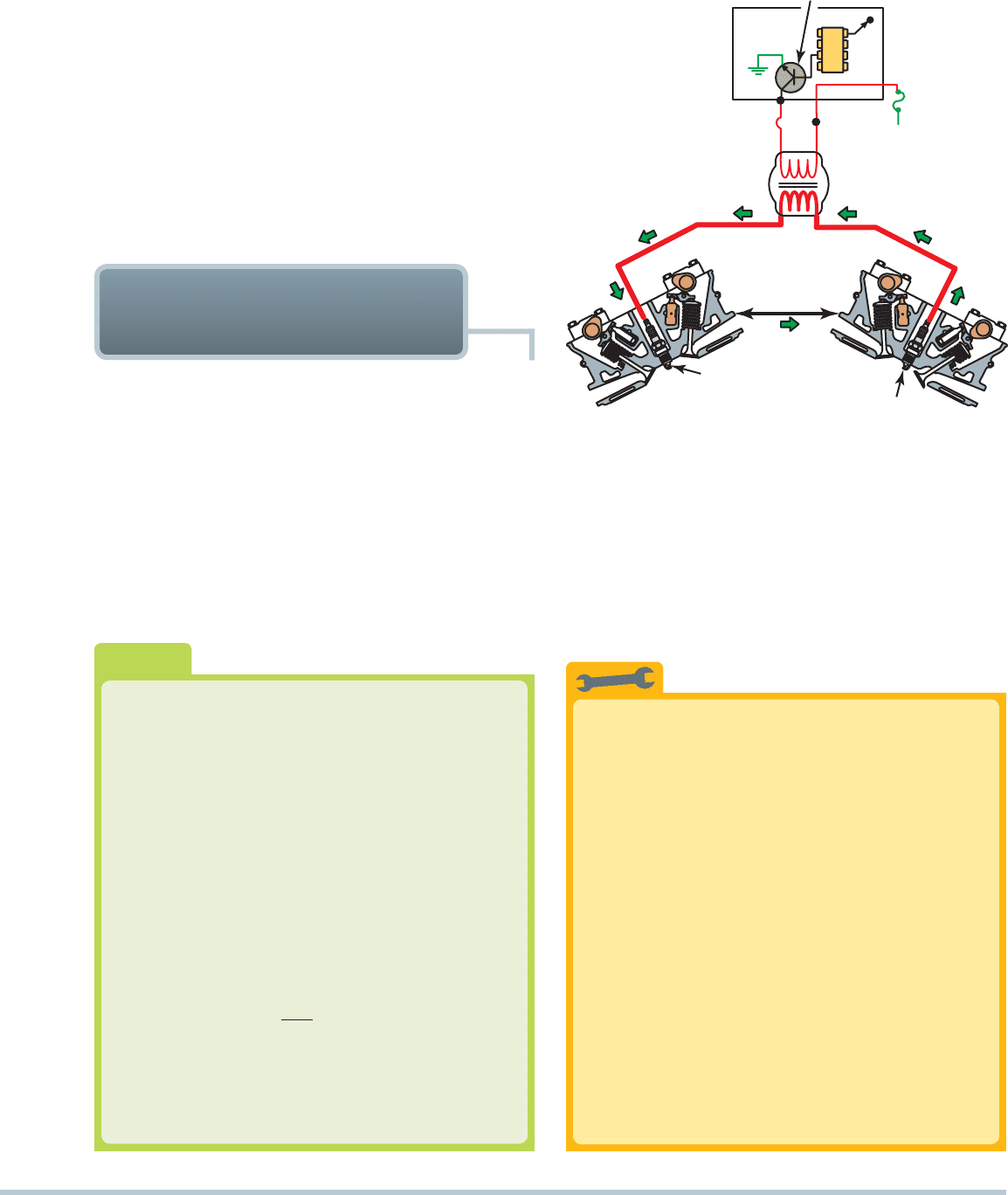
IGNITION SYSTEM OPERATION AND DIAGNOSIS 361
CAUTION: Ford V-8s use two different firing orders
depending on whether the engine is high output or
standard. Using the incorrect firing order can cause
the engine to backfire and could cause engine dam-
age or personal injury. General Motors V-6 engines use
different firing orders and different locations for cyl-
inder1 between the 60-degree V-6 and the 90-degree
V-6. Using the incorrect firing order or cylinder number
location chart could result in poor engine operation or a
no start. Firing order is also important for waste-spark-
type ignition systems. The spark plug wire can often be
installed on the wrong coil pack, which can create a no-
start condition or poor engine operation.
COMMON IRON
IC
PRIMARY CONTROL
TRANSISTOR
IGNITION
MODULE
B+
IGNITION
FUSE
CENTER
ELECTRODE
SIDE
ELECTRODE
EXHAUST
STROKE
COMPRESSION
STROKE
FIGURE 29–13 A waste-spark system fires one cylinder
while its piston is on the compression stroke and into paired
or companion cylinders while it is on the exhaust stroke. In
a typical engine, it requires only about 2 to 3 kV to fire the
cylinder on the exhaust stroke. The remaining coil energy is
available to fire the spark plug under compression (typically
about 8 to 12 kV).
How Can You Determine the Companion
Cylinder?
Companion cylinders are two cylinders in the same
engine that both reach top dead center (TDC) at the
same time:
• One cylinder is on the compression stroke.
• The other cylinder is on the exhaust stroke.
To determine which two cylinders are compan-
ion cylinders in the engine, follow these steps:
STEP 1 Determine the firing order (such as 165432
for a typical V-6 engine).
STEP 2 Write the firing order and then place the
second half under the first half:
165
432
STEP 3 The cylinder numbers above and below each
other are companion or paired cylinders.
In this case 1 and 4, 6 and 3, and 5 and 2 are
companion cylinders.
?
FREQUENTLY ASKED QUESTION
Odds Fire Straight
Waste-spark ignition systems fire two spark plugs
at the same time. Most vehicle manufacturers use a
waste-spark system that fires the odd number cyl-
inders (1, 3, and 5) by straight polarity (current flow
from the top of the spark plug through the gap and
to the ground electrode). The even number cylinders
(2, 4, and 6) are fired reverse polarity, meaning that
the spark jumps from the side electrode to the center
electrode. Some vehicle manufacturers equip their
vehicles with platinum plugs that have the expensive
platinum alloy on only one electrode, as follows:
• On odd number cylinders (1, 3, 5), the platinum is
on the center electrode.
• On even number cylinders (2, 4, 6), the platinum is
on the ground electrode.
Replacement spark plugs use platinum on both
electrodes (double platinum) and, therefore, can be
placed in any cylinder location.
TECH TIP
WASTE-SPARK IGNITION
SYSTEMS
PARTS INVOLVED Waste-spark ignition is another name
for distributorless ignition system (DIS) or electronic ignition.
Waste-spark ignition was introduced in the mid-1980s and uses
the ignition control module (ICM) and/or the powertrain control
module (PCM) to fire the ignition coils. A 4-cylinder engine uses
two ignition coils, and a 6-cylinder engine uses three ignition
coils. Each coil is a true transformer because the primary wind-
ing and secondary winding are not electrically connected. Each
end of the secondary winding is connected to a cylinder exactly
opposite the other in the firing order, which is called a compan-
ion (paired) cylinder.
SEE FIGURE 29–13 .
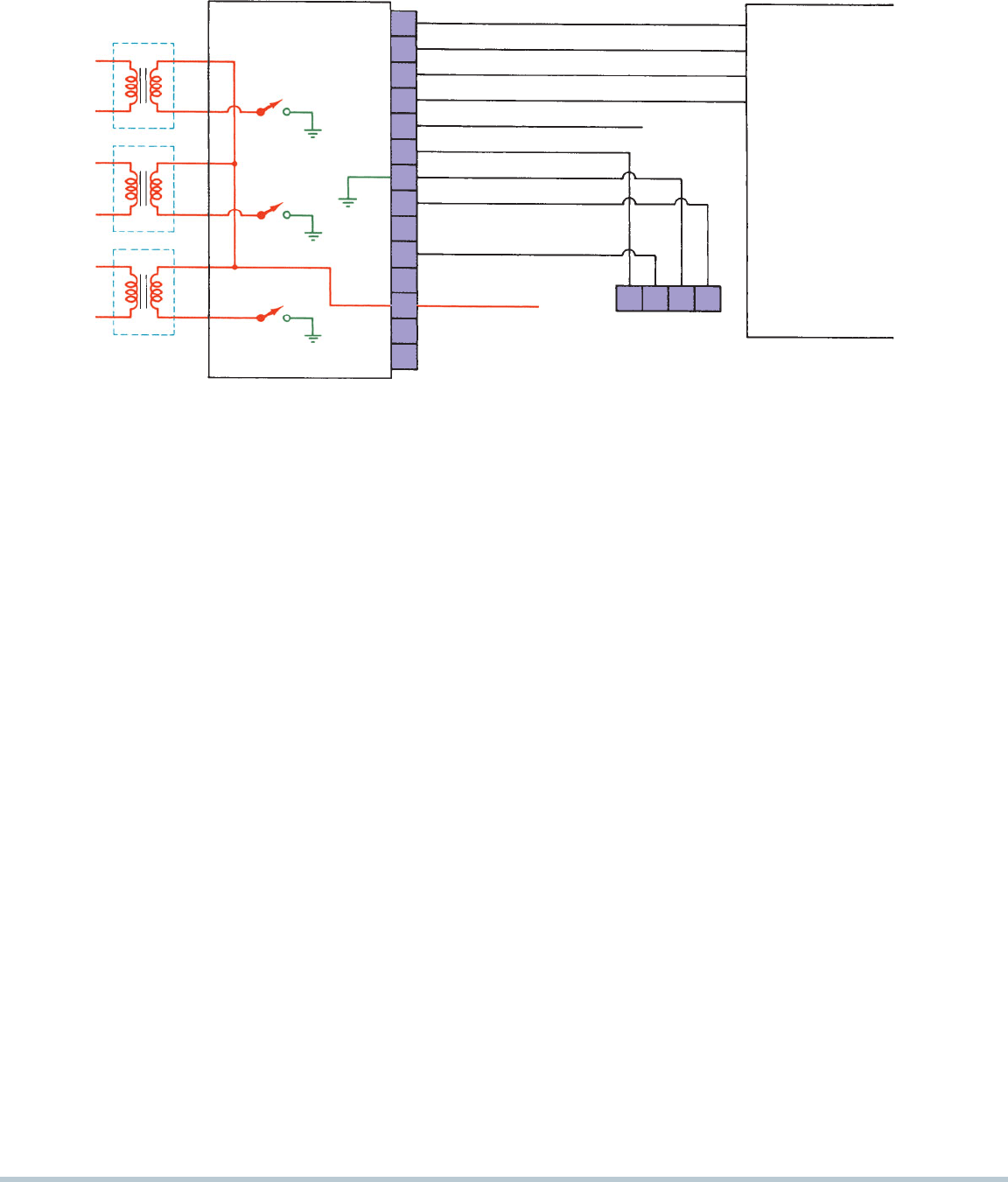
362 CHAPTER 29
WASTE-SPARK SYSTEM OPERATION Both spark
plugs fire at the same time (within nanoseconds of each other):
When one cylinder (for example, cylinder number 6) is on
the compression stroke, the other cylinder (number 3) is
on the exhaust stroke.
The spark that occurs on the exhaust stroke is called the
waste spark because it does no useful work andis only
used as a ground path for the secondary winding ofthe
ignition coil. The voltage required to jump the spark plug
gap on cylinder 3 (the exhaust stroke) is only 2 to 3 kV.
The cylinder on the compression stroke uses the
remaining coil energy.
One spark plug of each pair always fires straight polarity
(center to side electrode), and the other cylinder always
fires reverse polarity (side to center electrode). Spark plug
life is not greatly affected by the reverse polarity. If there
is only one defective spark plug wire or spark plug, two
cylinders may be affected.
The coil polarity is determined by the direction the coil is
wound (left-hand rule for conventional current flow) and cannot
be changed.
Each spark plug for a particular cylinder always will be fired
either with straight or reversed polarity, depending on its loca-
tion in the engine and how the coils are wired. However, the
compression and waste-spark condition flip-flops. When one
cylinder is on compression, such as cylinder 1, then the paired
cylinder (number 4) is on the exhaust stroke. During the next ro-
tation of the crankshaft, cylinder 4 is on the compression stroke,
and cylinder 1 is on the exhaust stroke:
Cylinder 1 Always fires straight polarity (from the center
electrode to the ground electrode), one time,
requiring 10 to 12 kV, and one time, requiring
3 to 4 kV.
Cylinder 4 Always fires reverse polarity (from the ground
electrode to the center electrode), one time,
requiring 10 to 12 kV, and one time, requiring
3 to 4 kV.
Waste-spark ignitions require a sensor (usually a crank-
shaft sensor) to trigger the coils at the correct time.
SEE
FIGURE 29–14 .
The crankshaft sensor cannot be moved to adjust ignition
timing because ignition timing is not adjustable. The slight ad-
justment of the crankshaft sensor is designed to position the
sensor exactly in the middle of the rotating metal disc for maxi-
mum clearance.
COMPRESSION-SENSING WASTE-SPARK IGNITION
Some waste-spark ignition systems, such as those used on
Saturns and others, use the voltage required to fire the cylin-
ders to determine cylinder position. It requires a higher voltage
to fire a spark plug under compression than it does when the
spark plug is being fired on the exhaust stroke. The electronics
in the coil and the PCM can detect which of the two compan-
ion (paired) cylinders that are fired at the same time requires
the higher voltage and therefore indicates the cylinder that is
on the compression stroke. For example, a typical 4-cylinder
engine equipped with a waste-spark ignition system will fire
both cylinders 1 and 4. If cylinder 4 requires a higher voltage
to fire, as determined by the electronics connected to the coil,
A
E
F
G
H
EST
BYPASS
TACH REF (REF HIGH)
GROUND (REF LOW)
J
K
L
M
N
COMPUTER
TACK
LEAD
P
PINK/BLACK
IGN B
A B C D
DUAL CRANK
SENSOR CONNECTOR
I
G
NITION
MODULE
(UNDER COILS)
COIL
ASSEMBLIES
CYLINDER 1
CYLINDER 2
CYLINDER 3
CYLINDER 4
CYLINDER 5
CYLINDER 6
B
C
WHITE
TAN/BLACK
PURPLE/WHITE
BLACK/RED
WHITE
LIGHT BLUE/WHITE
GRAY/RED
WHITE/BLACK
D
FIGURE 29–14 Typical wiring diagram of a GM V-6 waste-spark ignition system.
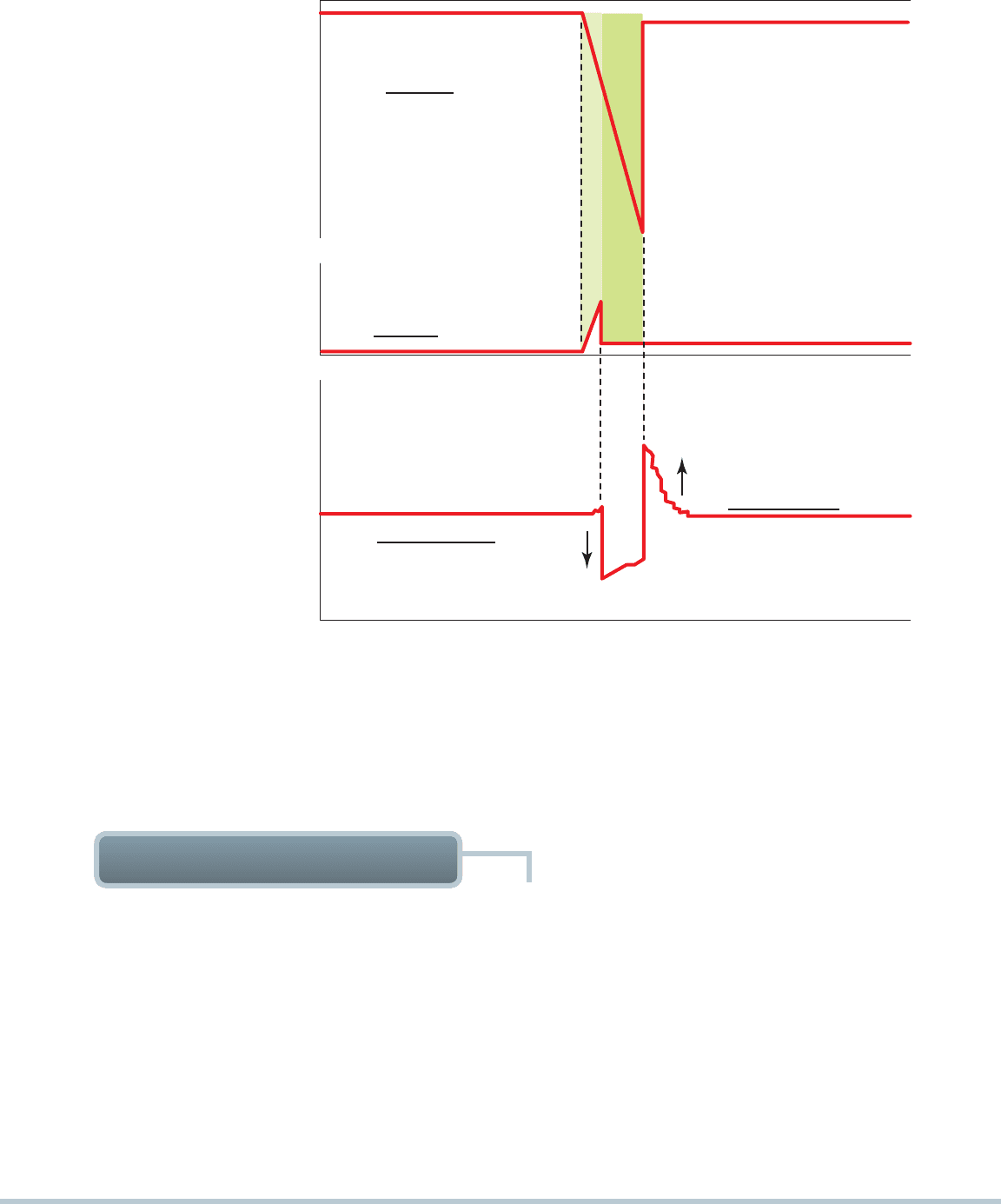
IGNITION SYSTEM OPERATION AND DIAGNOSIS 363
then the PCM assumes that cylinder 4 is on the compression
stroke. Engines equipped with compression-sensing ignition
systems do not require the use of a camshaft position sensor
to determine specific cylinder numbers.
SEE FIGURE 29–15 .
TYPES OF COP SYSTEMS There are two basic types of
COP ignition systems:
Two primary wires. This design uses the vehicle compu-
ter to control the firing of the ignition coil. The two wires
include the ignition voltage feed and the pulse ground
wire, which is controlled by the computer. The ignition
control module is located in the PCM, which handles all
ignition timing and coil on-time control.
Three primary wires. This design includes an ignition
module at each coil. The three wires include the following:
Ignition voltage
Ground
Pulse from the computer to the built-in ignition module
Vehicles use a variety of COP-type ignition systems, in-
cluding the following:
Many General Motors V-8 engines use a coil-near-plug
system with individual coils and modules for each in-
dividual cylinder that are placed on the valve covers.
Short secondary ignition spark plug wires are used to
connect the output terminal of the ignition coil to the
GROUND
GROUND
GROUND
-10KV
+4KV
8V
4V
5
μ
S
A NEGATIVE GOING VOLTAGE
A POSITIVE GOING VOLTAGE
CSI
SIGNAL
CYLINDERS
#2 OR #4
ON WASTE
CYLINDERS
#1 OR #3
ON COMPRESSION
CYLINDERS #4 AND #2 HAVE
BREAKOVER VOLTAGES THAT FALL
FROM ABOVE GROUND TOWARD GROUND
CYLINDERS #2 AND #4 HAVE
FIRING VOLTAGES THAT RISE
A POSITIVE DIRECTION
CYLINDERS #3 AND #1 HAVE
BREAKOVER VOLTAGES THAT RISE
FROM BELOW GROUND TOWARD GROUND
CYLINDERS #1 AND #3 HAVE
FIRING VOLTAGES THAT RISE
A NEGATIVE DIRECTION
FIGURE 29–15 The slight (5 microsecond) difference in the firing of the companion cylinders is enough time to allow the PCM to
determine which cylinder is firing on the compression stroke. The compression sensing ignition (CSI) signal is then processed by
the PCM which then determines which cylinder is on the compression stroke.
TERMINOLOGY Coil-on-plug (COP) ignition uses one
ignition coil for each spark plug. This system is also called
coil-by-plug, coil-near-plug, or coil-over-plug ignition.
SEE
FIGURES 29–16 AND 29–17 .
ADVANTAGES The COP system eliminates the spark plug
wires that are often the source of electromagnetic interference
(EMI) that can cause problems to some computer signals. The
vehicle computer controls the timing of the spark. Ignition tim-
ing also can be changed (retarded or advanced) on a cylinder-
by-cylinder basis for maximum performance and to respond to
knock sensor signals.
COIL-ON-PLUG IGNITION
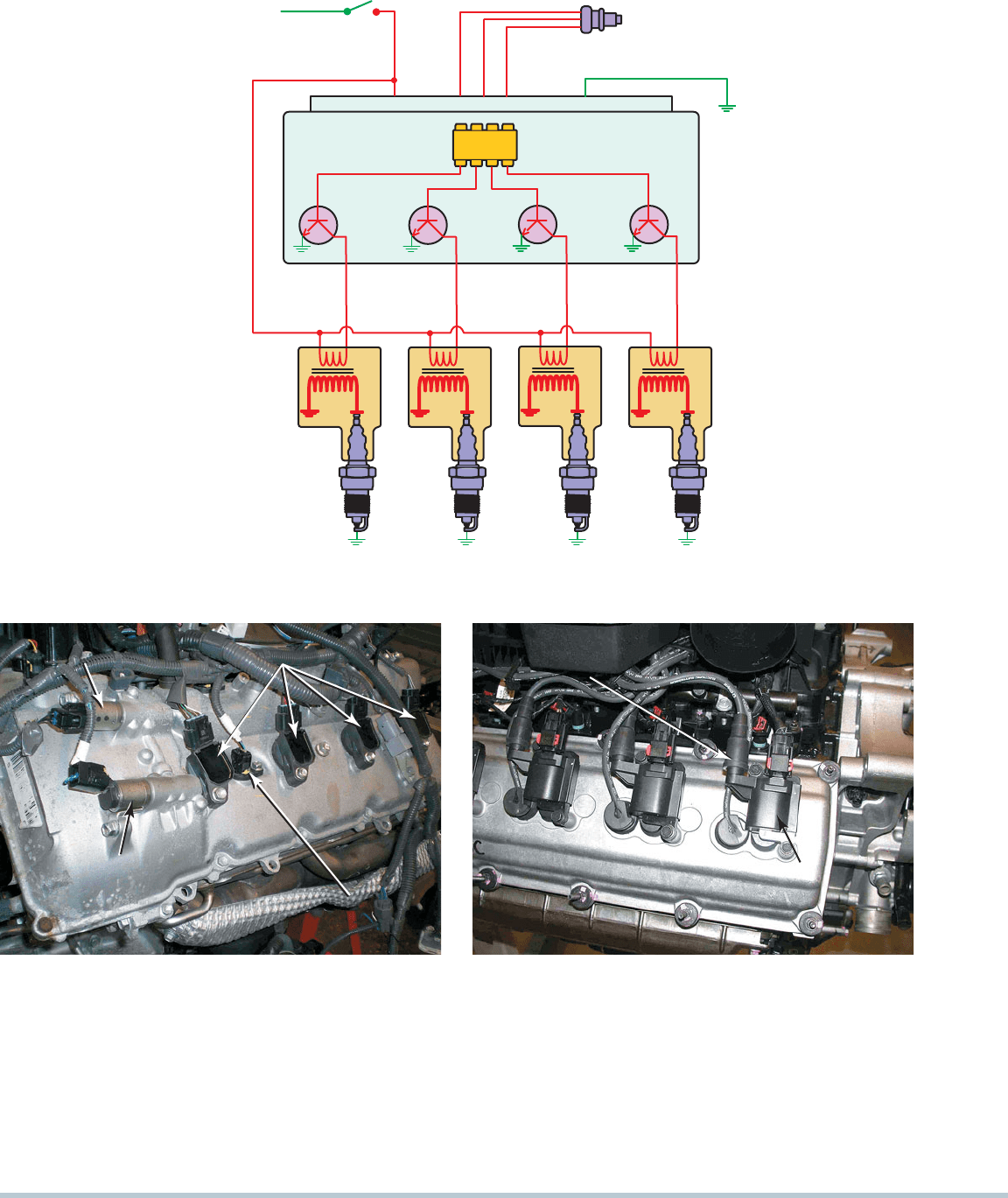
364 CHAPTER 29
CKP
SENSOR
B+
IGNITION
SWITCH
INTEGRAL
COIL AND PLUG
PCM
FIGURE 29–16 A typical two wire coil-on-plug (COP) ignition system showing the triggering and the switching being performed
by the PCM from input from the crankshaft position sensor.
INTAKE CAM
PHASER SOLENOID
COIL-ON-PLUG (COP)
COILS
EXHAUST CAM
PHASER
SOLENOID
CAMSHAFT
POSITION (CMP)
SENSOR
FIGURE 29–17 An overhead camshaft engine equipped
withvariable valve timing on both the intake and exhaust
camshafts and coil-on-plug (COP) ignition.
COIL
SPARK PLUG WIRE
TO COMPANION
CYLINDER
FIGURE 29–18 A Chrysler Hemi V-8 that has two spark plugs
per cylinder. The coil on top of one spark fires that plug and,
through a spark plug wire, fires a plug in the companion cylinder.
spark plug, and therefore this system is called a coil-
near-plug system.
In a combination of COP and waste-spark systems, the
systems fire a spark plug attached to the coil and use a
spark plug wire attached to the other secondary terminal
of the coil to fire another spark plug of the companion cyl-
inder. This type of system is used in some Chrysler Hemi
V-8 and Toyota V-6 engines.
SEE FIGURE 29–18 .
Most new engines use coil-on-plug-type ignition systems.
Each coil is controlled by the PCM, which can vary the ignition
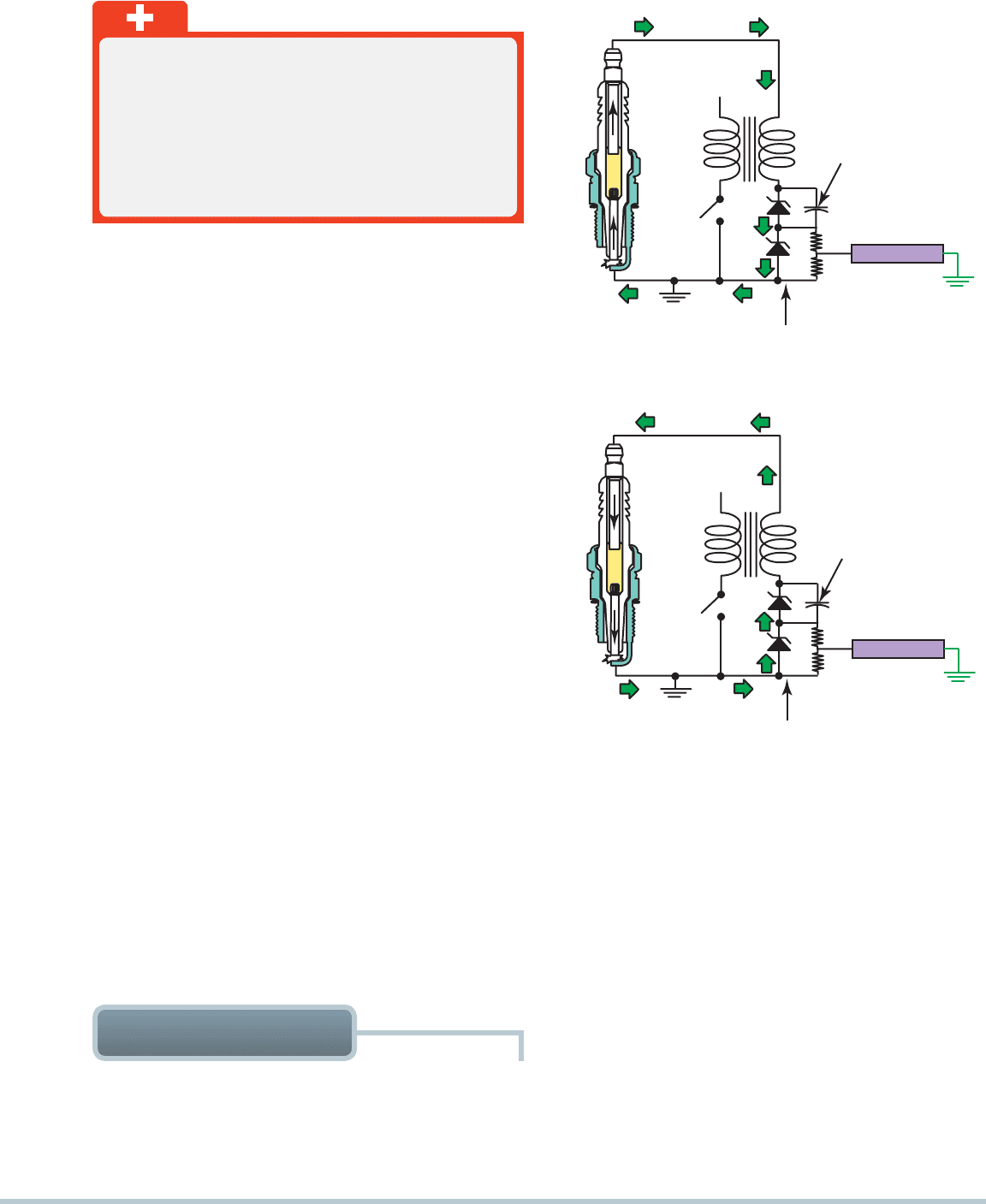
IGNITION SYSTEM OPERATION AND DIAGNOSIS 365
timing separately for each cylinder based on signals the PCM
receives from the knock sensor(s). For example, if the knock
sensor detects that a spark knock has occurred after firing
cylinder 3, then the PCM will continue to monitor cylinder 3
and retard timing on just this one cylinder if necessary to pre-
vent engine-damaging detonation.
ION-SENSING IGNITION In an ion-sensing ignition sys-
tem, the spark plug itself becomes a sensor. An ion-sensing igni-
tion uses a COP design where the ignition control module (ICM)
applies a DC voltage across the spark plug gap after theignition
event to sense the ionized gases (called plasma) inside the cyl-
inder. Ion-sensing ignition is used in the General Motors EcoTec
4-cylinder engines.
SEE FIGURE 29–19 .
The secondary coil discharge voltage (10 to 15 kV) is elec-
trically isolated from the ion-sensing circuit. The combustion
flame is ionized and will conduct some electricity, which can be
accurately measured at the spark plug gap. The purpose of this
circuit includes the following:
Misfire detection (required by OBD-II regulations)
Knock detection (eliminates the need for a knock sensor)
Ignition timing control (to achieve the best spark timing
for maximum power with lowest exhaust emissions)
Exhaust gas recirculation (EGR) control
Air-fuel ratio control on an individual cylinder basis
Ion-sensing ignition systems still function the same as
conventional COP designs, but the engine does not need to be
equipped with a camshaft position sensor for misfire detection
or a knock sensor because both of these faults are achieved
using the electronics inside the ignition control circuits.
in the engine block. It is this vibration that is detected by the
knock sensor. The signal from the knock sensor is used by the
PCM to retard the ignition timing until the knock is eliminated,
thereby reducing the damaging effects of the abnormal com-
bustion on pistons and other engine parts.
Inside the knock sensor is a piezoelectric element that
is a type of crystal that produces a voltage when pressure
or a vibration is applied to the unit. The knock sensor is
tuned to the engine knock frequency, which is a range from
B+
D1
D2
C1
R1
R2
SPARK
CHARGED TO
80 VOLTS
SPARK EVENT—SPARK CURRENT FLOW
ISIM COMPONENTS ADDED
TO SECONDARY CIRCUIT
ION SIGNAL
B+
D1
D2
C1
R1
R2
DISCHARGING
80 VOLTS
ISIM COMPONENTS ADDED
TO SECONDARY CIRCUIT
MEASUREMENT PERIOD—ON CURRENT FLOW
ION
FLOW
ION SIGNAL
FIGURE 29–19 A DC voltage is applied across the spark
plug gap after the plug fires, and the circuit can determine
if the correct air-fuel ratio was present in the cylinder and
if knock occurred. The applied voltage for ion-sensing
does not jump the spark plug gap but determines the con-
ductivity of the ionized gases left over from the combustion
process.
Never Disconnect a Spark Plug Wire When
the Engine Is Running!
Ignition systems produce a high-voltage pulse nec-
essary to ignite a lean air-fuel mixture. If you discon-
nect a spark plug wire when the engine is running,
this high-voltage spark could cause personal injury
or damage to the ignition coil and/or ignition module.
SAFETY TIP
PURPOSE AND FUNCTION Knock sensors are used to
detect abnormal combustion, often called ping, spark knock,
or detonation. Whenever abnormal combustion occurs, a rapid
pressure increase occurs in the cylinder, creating a vibration
KNOCK SENSORS
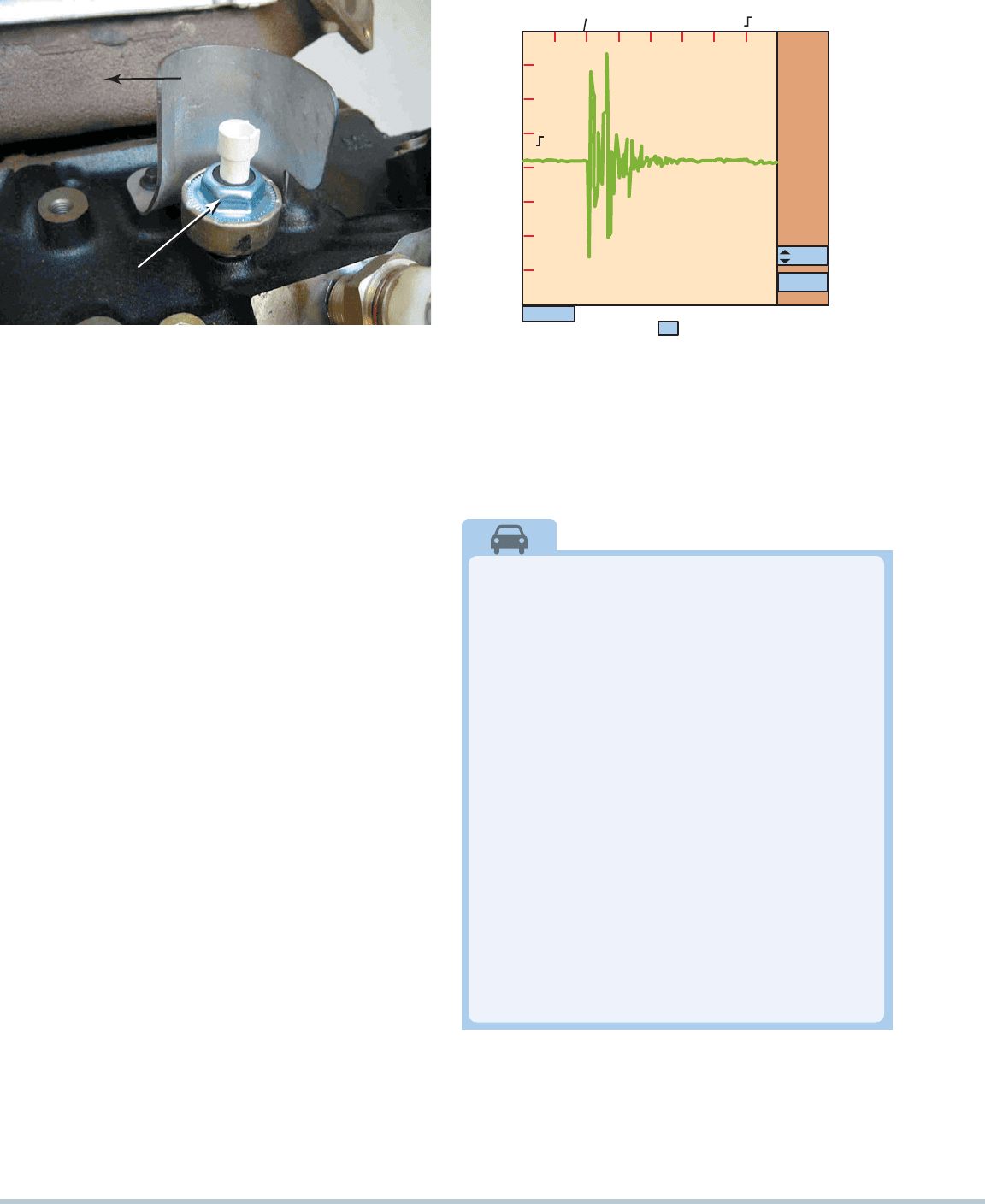
366 CHAPTER 29
5 to 10 kHz, depending on the engine design. The voltage
signal from the knock sensor is sent to the PCM. The PCM
retards the ignition timing until the knocking stops.
SEE
FIGURE 29–20 .
DIAGNOSING THE KNOCK SENSOR If a knock sensor
diagnostic trouble code (DTC) is present, follow the specified
testing procedure in the service information. A scan tool can
be used to check the operation of the knock sensor, using the
following procedure:
STEP 1 Start the engine and connect a scan tool to monitor
ignition timing and/or knock sensor activity.
STEP 2 Create a simulated engine knocking sound by tapping
on the engine block or cylinder head with a soft-faced
mallet or small ball peen hammer.
STEP 3 Observe the scan tool display. The vibration from the
tapping should have been interpreted by the knock
sensor as a knock, resulting in a knock sensor signal
and a reduction in the spark advance.
A knock sensor also can be tested using a digital storage
oscilloscope.
SEE FIGURE 29–21 .
NOTE: Some engine computers are programmed to ig-
nore knock sensor signals when the engine is at idle
speed to avoid having the noise from a loose acces-
sory drive belt or other accessory interpreted as engine
knock. Always follow the vehicle manufacturer’s recom-
mended testing procedure.
REPLACING A KNOCK SENSOR If replacing a knock
sensor, be sure to purchase the exact replacement needed,
because they often look the same, but the frequency range can
vary according to engine design and location on the engine.
Always tighten the knock sensor using a torque wrench and
tighten to the specified torque to avoid causing damage to the
piezoelectric element inside the sensor.
EXHAUST
MANIFOLD
KNOCK
SENSOR
FIGURE 29–20 A typical knock sensor on the side of the
block. Some are located in the “V” of a V-type engine and are
not noticeable until the intake manifold has been removed.
A 50V AC 1:1 PROBE B 200mV OFF 1:1 PROBE
500uS / DIV SINGLE TRIG:A -2DIV
A
SINGLE FREE CAPTURE MIN MAX TRIGGER
RECURRENT RUN 10 20 DIV ON A AT 50%
ZOOM
HOLD
A
FIGURE 29–21 A typical waveform from a knock sensor
during a spark knock event. This signal is sent to the compu-
ter, which in turn retards the ignition timing. This timing retard
is accomplished by an output command from the computer to
either a spark advance control unit or directly to the ignition
module.
The Low-Power Toyota
A technician talked about the driver of a Toyota who
complained about poor performance and low fuel
economy. The technician checked everything and
even replaced all secondary ignition components.
Then the technician connected a scan tool and
noticed that the knock sensor was commanding
the timing to be retarded. Careful visual inspection
revealed a “chunk” missing from the serpentine belt,
which caused a “noise” similar to a spark knock.
Apparently the knock sensor was “hearing” the
accessory drive belt noise and kept retarding the
ignition timing. After replacing the accessory drive
belt, a test drive confirmed that normal engine power
was restored.
Other items that can fool the knock sensor to
retard the ignition timing include the following:
• Loose valve lifter adjustment
• Engine knocks
• Loose accessory brackets such as air-conditioning
compressor, power steering pumps, or alternator
REAL WORLD FIX
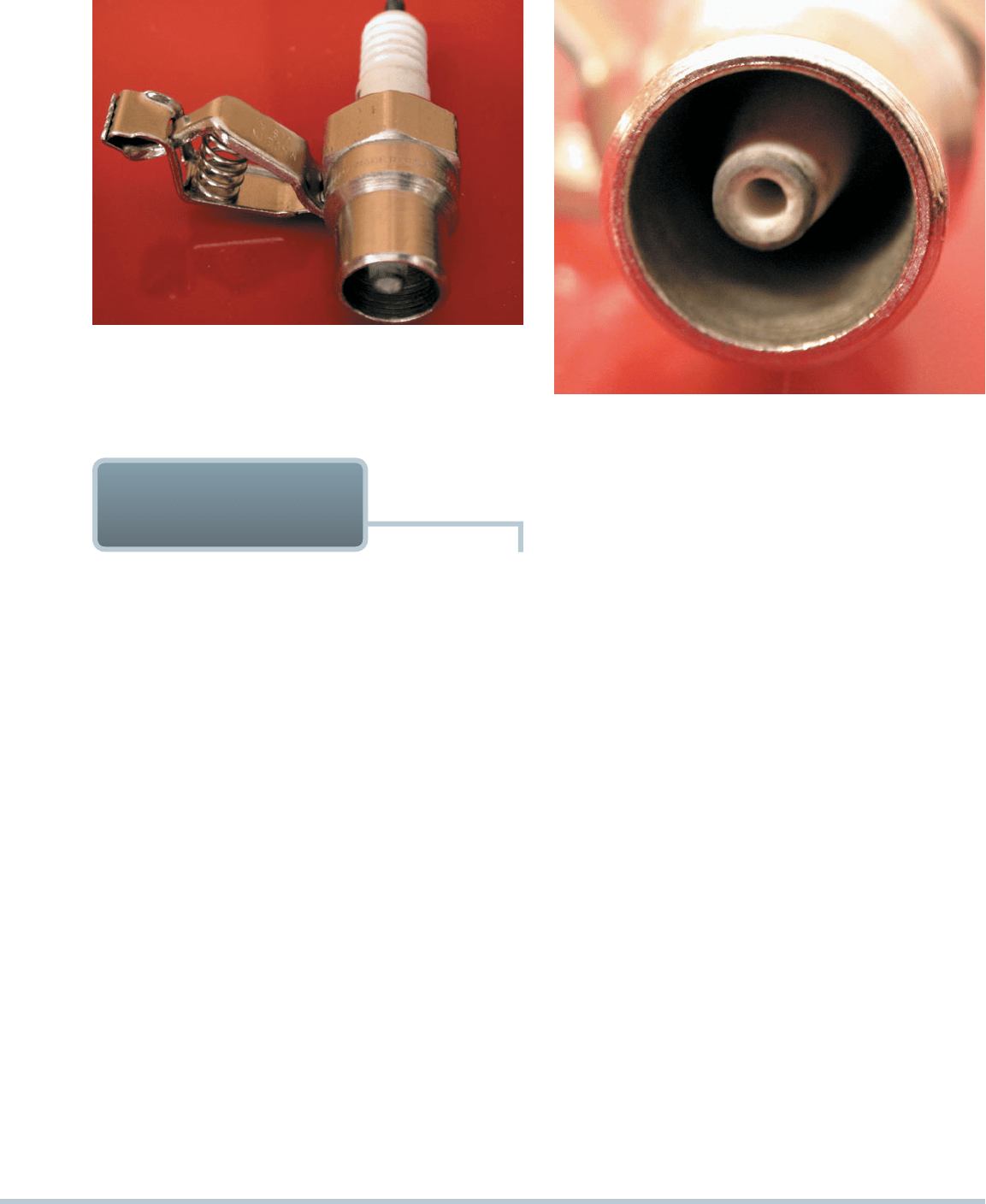
IGNITION SYSTEM OPERATION AND DIAGNOSIS 367
The triggering sensor has to work to create a spark from
the ignition coil(s). If there is a no-spark condition, check for
triggering by using a scan tool and check for engine RPM while
cranking the engine:
If the engine speed (RPM) shows zero or almost zero
while cranking, the most likely cause is a defective trig-
gering sensor or sensor circuit fault.
If the engine speed (RPM) is shown on the scan tool while
cranking the engine, then the triggering sensor is working
(in most cases).
Check service information for the exact procedure to
follow for testing triggering sensors.
IGNITION COIL TESTING USING AN OHMMETER If
an ignition coil is suspected of being defective, a simple ohm-
meter check can be performed to test the resistance of the
primary and secondary windings inside the coil. For accu-
rate resistance measurements, the wiring to the coil should be
removed before testing. To test the primary coil winding resis-
tance, take the following steps:
SEE FIGURE 29–24 .
STEP 1 Set the meter to read low ohms.
STEP 2 Measure the resistance between the positive terminal
and the negative terminal of the ignition coil. Most
coils will give a reading between less than 1 ohm and
3 ohms. Check the manufacturer’s specifications for
the exact resistance values.
FIGURE 29–22 A spark tester looks like a regular spark plug
with an alligator clip attached to the shell. This tester has a
specified gap that requires at least 25,000 volts (25 kV) to fire.
FIGURE 29–23 A close-up showing the recessed center
electrode on a spark tester. It is recessed 3/8 inch into the
shell, and the spark must then jump another 3/8 inch to the
shell for a total gap of 3/4 inch.
IGNITION SYSTEM
DIAGNOSIS
CHECKING FOR SPARK In the event of a no-start
condition, the first step should be to check for secondary
voltage out of the ignition coil or to the spark plugs. If the
engine is equipped with a separate ignition coil, remove the
coilwire from the center of the distributor cap, install a spark
tester and crank the engine. See the Tech Tip “Always Use
aSpark Tester.” A good coil and ignition system should pro-
duce a blue spark at the spark tester.
SEE FIGURES 29–22
AND 29–23 .
If the ignition system being tested does not have a sepa-
rate ignition coil, disconnect any spark plug wire from a spark
plug and, while cranking the engine, test for spark available at
the spark plug wire, again using a spark tester.
NOTE: An intermittent spark should be considered a no-
spark condition.
Typical causes of a no-spark (intermittent spark) condition
include the following:
1. Weak ignition coil
2. Low or no voltage to the primary (positive) side of the coil
3. High resistances, open coil wire, or spark plug wire
4. Negative side of the coil not being pulsed by the ignition
module
5. Defective pickup coil or crankshaft position sensor
6. Defective ignition control module (ICM)
7. Defective main relay (can be labeled Main, EFI, ASD on
Chrysler products; EEC on Ford vehicle relays)

368 CHAPTER 29
COM
A
mA A
mV
V
V
mA
A
A
V
DIGITAL MULTIMETER
RECORD
MAX MIN
HZ
%
10
2
345
6
7
8
9
0
HZ
MAXMIN
1. INSERT TEST LEADS IN THE INPUT TERMINALS SHOWN.
2. TURN THE ROTARY SWITCH TO Ω.
3. TOUCH THE PROBES AS SHOWN TO MEASURE RESISTANCE
IN PRIMARY WINDINGS.
4. OBSERVE DISPLAY. RESISTANCE SHOULD BE LESS THAN
1 TO 3 OHMS.
5. TOUCH PROBES AS SHOWN TO MEASURE RESISTANCE IN
SECONDARY WINDINGS.
6. OBSERVE DISPLAY. RESISTANCE SHOULD TYPICALLY BE
6,000 TO 30,000 OHMS.
1
2
3
5
4
6
FIGURE 29–24 Checking an ignition coil using a multimeter set to read ohms.
Always Use a Spark Tester
A spark tester looks like a spark plug except it has
a recessed center electrode and no side electrode.
The tester commonly has an alligator clip attached to
the shell so that it can be clamped on a good ground
connection on the engine. A good ignition system
should be able to cause a spark to jump this wide
gap at atmospheric pressure. Without a spark tester,
a technician might assume that the ignition sys-
tem is okay because it can spark across a normal,
grounded spark plug. The voltage required to fire a
standard spark plug when it is out of the engine and
not under pressure is about 3,000 volts or less. An
electronic ignition spark tester requires a minimum
of 25,000 volts to jump the 3/4-inch gap. There-
fore, never assume that the ignition system is okay
because it fires a spark plug—always use a spark
tester. Remember that an intermittent spark across
a spark tester should be interpreted as a no-spark
condition.
TECH TIP
To test the secondary coil winding resistance, follow
these steps:
STEP 1 Set the meter to read kilohms (kΩ).
STEP 2 Measure the resistance either between the primary termi-
nal and the secondary coil tower or between the second-
ary towers. The normal resistance of most coils ranges
between 6,000 and 30,000 ohms. Check the manufac-
turer’s specifications for the exact resis tance values.
MAGNETIC SENSOR TESTING Magnetic Sensor such
as the pickup coil, located under the distributor cap on many
electronic ignition engines, can cause a no-spark condition if
defective. The sensor must generate an AC voltage pulse to the
ignition module so that the module can pulse the ignition coil.
The sensor contains a coil of wire, and the resistance of this
coil should be within the range specified by the manufacturer.
Some common tests for pickup coils and magnetic crank-
shaft position sensors include the following:
Resistance. Usually between 150 and 1,500 ohms, but
check service information for the exact specifications.
SEE FIGURE 29–25 .
Coil shorted to ground. Check that the coil windings
are insulated from ground by checking for continuity
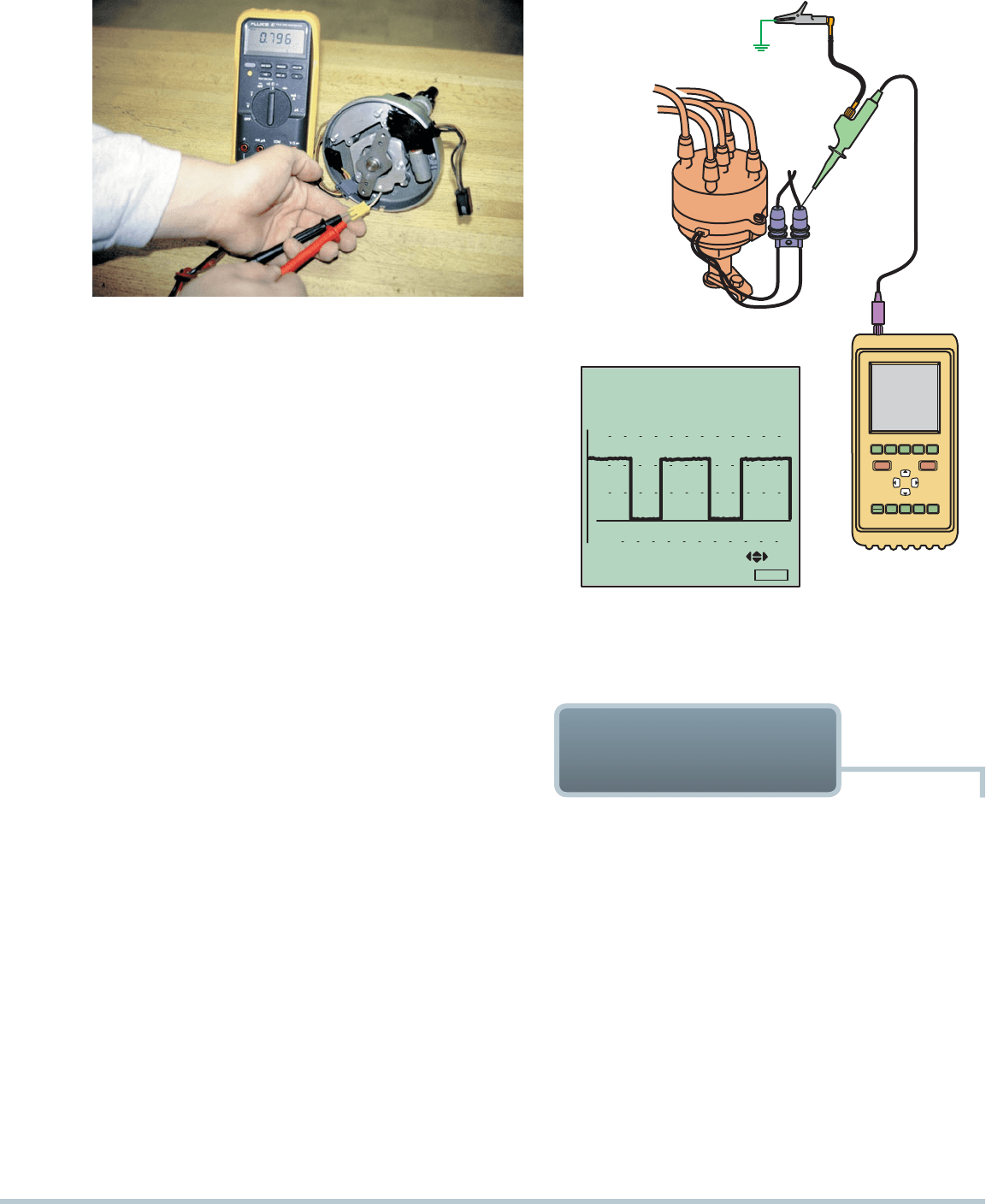
IGNITION SYSTEM OPERATION AND DIAGNOSIS 369
using an ohmmeter. With one ohmmeter lead attached
to ground, touch the other lead of the ohmmeter to the
pickup coil terminal. The ohmmeter should read OL
(over limit) with the ohmmeter set on the high scale. If
the sensor resistance is not within the specified range
or if it has continuity to ground, replace the pickup coil
assembly.
AC voltage output. The sensor also can be tested for
proper voltage output. During cranking, most sensors
should produce a minimum of 0.25 volt AC.
TESTING HALL-EFFECT SENSORS As with any other
sensor, the output of the Hall-effect sensor should be tested
first. Using a digital voltmeter, check for the following:
Power and ground to the sensor
Changing voltage (pulsed on and off or digital DC volt-
age) when the engine is being cranked
Waveform, using an oscilloscope SEE FIGURE 29–26 .
TESTING OPTICAL SENSORS Optical sensors will not
operate if they are dirty or covered in oil. Perform a thorough
visual inspection and look for an oil leak that could cause dirty
oil to get on the LED or phototransistor. Also be sure that the
light shield is securely fastened and that the seal is lightproof.
An optical sensor also can be checked using an oscilloscope.
SEE FIGURE 29–27 .
Because of the speed of the engine and the number
of slits in the optical sensor disk, a scope is one of the only
tools that can capture useful information. For example, a
Nissan has 360 slits, and if it is running at 2,000 RPM, a sig-
nal is generated 720,000 times per minute, or 12,000 times
per second.
FIGURE 29–25 Measuring the resistance of an HEI pickup
coil using a digital multimeter set to the ohms position. The
reading on the face of the meter is 0.796 kΩ, or 796 ohms in
the middle of the 500- to 1,500-ohm specifications.
MENU
RECORD
SAVE
RECALL
AUTO
RANGE
AUTOMOTIVE SCOPMETER
0
5
10
15
20
25
-5
VEHICLE
DATA
PRADE
SINGLE
RANGE
HOLD
0
AUTO
KEYS
RANGE
HALL-EFFECT SENSOR
4.72 V PEAK - PEAK
127 HZ FREQUENCY
42.0 % DUTY CYCLE
3.06 MS PULSE WIDTH
2
4
6V
-2V
2MS/DIV
FIGURE 29–26 The connection required to test a Hall-effect
sensor. A typical waveform from a Hall-effect sensor.
SPARK PLUG WIRE
INSPECTION
Spark plug wires should be visually inspected for cuts or de-
fective insulation. Faulty spark plug wire insulation can cause
hard starting or no starting in rainy or damp weather conditions.
When removing a spark plug wire, be sure to rotate the boot of
the wire at the plug before pulling it off the spark plug. This will
help prevent damaging the wire, as many wires are stuck to the
spark plug and are often difficult to remove.
VISUAL INSPECTION A thorough visual inspection should
include a look at the following items:
Check all spark plug wires for proper routing. All plug
wires should be in the factory wiring separators and be
clear of any metallic object that could damage the insu-
lation and cause a short-to-ground fault.
Check that all spark plug wires are securely attached
to the spark plugs and to the distributor cap or ignition
coil(s).

370 CHAPTER 29
ZOOM
HOLD
A 2V DC 1:1 PROBE B 200mV OFF 1:1 PROBE
10ms / TRIG:A -1 DIV
A
SINGLE FREE CAPTURE MIN MAX TRIGGER
RECURRENT RUN 10 20 DIV ON A AT 50%
ZOOM
HOLD
A 2V DC 1:1 PROBE B 200mV OFF 1:1 PROBE
10ms / TRIG:A -1 DIV
A
SINGLE FREE CAPTURE MIN MAX TRIGGER
RECURRENT RUN 10 20 DIV ON A AT 50%
A
A
B
(
a
)(
b
)
FIGURE 29–27 (a) The low-resolution signal has the same number of pulses as the engine has cylinders. (b) A dual-trace pattern
showing both the low-resolution signal and the high-resolution signals that usually represent 1 degree of rotation.
AIR
GAP
PRIMARY COIL
WINDINGS
TRACKING
TO STEEL
CORE
STEEL
CORE
SECONDARY COIL
WINDINGS
COIL EPOXY
CASE
FIGURE 29–28 A track inside an ignition coil is not a short
but a low-resistance path or hole that has been burned
through from the secondary wiring to the steel core.
Bad Wire? Replace the Coil!
When performing engine testing (such as a compres-
sion test), always ground the coil wire. Never allow
the coil to discharge without a path to ground for the
spark. High-energy ignition systems can produce
40,000 volts or more of electrical pressure. If the
spark cannot spark to ground, the coil energy can
(and usually does) arc inside the coil itself, creating
a low-resistance path to the primary windings or the
steel laminations of the coil.
SEE FIGURE 29–28 .
This low-resistance path is called a track and
could cause an engine miss under load even though
all of the remaining component parts of the ignition
system are functioning correctly. Often these tracks
do not show up on any coil test, including most
scopes. Because the track is a lower resistance path
to ground than normal, it requires that the ignition
system be put under a load for it to be detected, and
even then, the misfire may be intermittent. If a misfire
was the result of an open circuit in the secondary
circuit, the coil is ruined and must be replaced.
When disabling an ignition system, perform one
of the following procedures to prevent possible igni-
tion coil damage:
1. Remove the power source wire from the ignition
system to prevent any ignition operation.
2. On distributor-equipped engines, remove the sec-
ondary coil wire from the center of the distributor
cap and connect a jumper wire between the dis-
connected coil wire and a good engine ground. This
ensures that the secondary coil energy will be safely
grounded and prevents high-voltage coil damage.
TECH TIP
Check that all spark plug wires are clean and free from
excessive dirt or oil. Check that all protective covers nor-
mally covering the coil and/or distributor cap are in place
and not damaged.
Carefully check the cap and distributor rotor for faults
or coil secondary terminal on waste spark coils.
SEE
FIGURE 29–29 .
Visually check the wires and boots for damage. SEE
FIGURE 29–30 .
Check all spark plug wires with an ohmmeter for proper
resistance. Good spark plug wires should measure less than
10,000 ohms per foot of length.
SEE FIGURE 29–31 .
